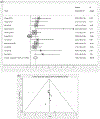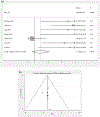High mobility group A protein-2 as a tumor cancer diagnostic and prognostic marker: a systematic review and meta-analysis
- PMID: 32898013
- PMCID: PMC11537243
- DOI: 10.1097/CEJ.0000000000000602
High mobility group A protein-2 as a tumor cancer diagnostic and prognostic marker: a systematic review and meta-analysis
Abstract
High mobility group A protein-2 (HMGA2) is an architectural transcription factor that binds to the A/T-rich DNA minor groove and is responsible for regulating transcriptional activity of multiple genes indirectly through chromatin change and assembling enhanceosome. HMGA2 is overexpressed in multiple tumor types, suggesting its involvement in cancer initiation and progression, thus, making it an ideal candidate for cancer diagnostic and prognostic. We performed a systematic review to examine the role of HMGA2 as a universal tumor cancer diagnostic and prognostic marker. We used Reporting Recommendations for Tumor Marker Prognostic Studies to systematically search OvidMedline, PubMed, and the Cochrane Library for English language studies, published between 1995 and June 2019. Meta-analysis provided pooled risk estimates and their 95% confidence intervals (CIs) for an association between overall survival and recurrence of cancers for studies with available estimates. We identified 42 eligible studies with a total of 5123 tumor samples in 15 types of cancer. The pooled percentage of HMGA2 gene expression in tumor samples was 65.14%. Meta-analysis showed that cancer patients with HMGA2 positive have significantly reduced survival, compared to patients without HMGA2 gene [pooled-hazard ratio (HR) = 1.85, 95% CI 1.48-2.22]. There was a positive association between cancer patients with HMGA2 overexpression and cancer recurrence though this association did not reach significance (pooled-HR = 1.44, 95% CI 0.80-2.07). Overexpression of HMGA2 was found in 15 types of cancer. There was an association between HMGA2 overexpression with reduced survival of cancer patients. HMGA2 is thus considered a promising universal tumor marker for prognostics.
Conflict of interest statement
Conflicts of interest
There are no conflicts of interest.
Figures



Similar articles
-
Prognostic value of high mobility group protein A2 (HMGA2) over-expression in cancer progression.Gene. 2019 Jul 20;706:131-139. doi: 10.1016/j.gene.2019.04.088. Epub 2019 May 2. Gene. 2019. PMID: 31055021
-
High HMGA2 Expression Correlates with Reduced Recurrence-free Survival and Poor Overall Survival in Oral Squamous Cell Carcinoma.Anticancer Res. 2017 Apr;37(4):1891-1899. doi: 10.21873/anticanres.11527. Anticancer Res. 2017. PMID: 28373457
-
Clinicopathological and prognostic significance of HMGA2 overexpression in gastric cancer: a meta-analysis.Oncotarget. 2017 Jul 5;8(59):100478-100489. doi: 10.18632/oncotarget.19001. eCollection 2017 Nov 21. Oncotarget. 2017. PMID: 29245994 Free PMC article.
-
Diagnostic performance of HMGA2 gene expression for differentiation of malignant thyroid nodules: A systematic review and meta-analysis.Clin Endocrinol (Oxf). 2018 Dec;89(6):856-862. doi: 10.1111/cen.13853. Epub 2018 Oct 10. Clin Endocrinol (Oxf). 2018. PMID: 30223300
-
The role of let-7 and HMGA2 in the occurrence and development of lung cancer: a systematic review and meta-analysis.Eur Rev Med Pharmacol Sci. 2018 Dec;22(23):8353-8366. doi: 10.26355/eurrev_201812_16533. Eur Rev Med Pharmacol Sci. 2018. PMID: 30556876
Cited by
-
Decoding high mobility group A2 protein expression regulation and implications in human cancers.Discov Oncol. 2024 Jul 31;15(1):322. doi: 10.1007/s12672-024-01202-x. Discov Oncol. 2024. PMID: 39085703 Free PMC article. Review.
-
High mobility group A2 (HMGA2) protein tissue levels and its association with clinicopathological features in bladder cancer patients.Discov Oncol. 2025 Aug 25;16(1):1622. doi: 10.1007/s12672-025-03462-7. Discov Oncol. 2025. PMID: 40853523 Free PMC article.
-
Investigating the role of HMGA2 plasma level as a diagnostic marker in bladder urothelial carcinoma patients.J Cancer Res Clin Oncol. 2025 Apr 9;151(4):134. doi: 10.1007/s00432-025-06192-z. J Cancer Res Clin Oncol. 2025. PMID: 40204943 Free PMC article.
References
-
- American Cancer Society (2018). Cancer Facts & Figures 2018. Atlanta, Georgia: American Cancer Society..
-
- Arora N, Scognamiglio T, Lubitz CC, Moo TA, Kato MA, Zhu B, et al. (2009). Identification of borderline thyroid tumors by gene expression array analysis. Cancer 115:5421–5431. - PubMed
-
- Belge G, Meyer A, Klemke M, Burchardt K, Stern C, Wosniok W, et al. (2008). Upregulation of HMGA2 in thyroid carcinomas: a novel molecular marker to distinguish between benign and malignant follicular neoplasias. Genes Chromosomes Cancer 47:56–63. - PubMed
-
- Bigbee W, Herberman R (2003). Tumor markers and immunodiagnosis. In: Bast RC, Kufe DW, Pollock RE, et al., editors. Cancer Medicine. Hamilton, ON: BC: Decker, pp. 209–220.
Publication types
MeSH terms
Substances
Grants and funding
LinkOut - more resources
Full Text Sources
Medical

